Urbanization-Induced Diurnal Variation in Short-Duration Rainfall Events in Wuhan, China
Abstract
:1. Introduction
2. Materials and Methodologies
2.1. Data
2.2. Study Area
2.3. Methods
2.3.1. Definition of the Summer Dry Period
2.3.2. Classification of Urban and Rural Stations
2.3.3. Definition of Rainfall Variables
2.3.4. Definition of the Urbanization Indicator
3. Results
3.1. Diurnal Urban-Rural Differences in Rainfall Variables
3.2. Diurnal Urban-Rural Differences in SDR Variables
3.3. UHI-Induced Impacts on SDR
4. Discussion
5. Conclusions
- The diurnal variation in the frequency of hourly rainfall shows a bimodal structure over the Wuhan area, with the peaks at night-time (2200–0600 Local Time) and afternoon (1400–1900 Local Time), respectively. More urban rainfall is concentrated at night-time and afternoon, which differs from the pattern of rural rainfall. Obviously greater frequency is exhibited over and downwind of Wuhan urban areas but is more concentrated on the urban areas during the night-time;
- The diurnal variations of SDR events also reveal a bimodal structure over the Wuhan area, with peaks in the early morning (0600–1200 Local Time) and afternoon. An enhancement in urban SDR events can be seen during the night-time when compared to the rural events, especially in amount and intensity. More numerous and intense SDR events occur over and downwind of urban areas but they are also more concentrated on the urban areas during the night-time. A greater diurnal urban-rural difference in SDR variables is detected than that in hourly rainfall during the dry summer over the Wuhan area;
- An obvious difference exists in the diurnal variations in urban SDR events when affected by different urban heat islands before the event initiated. There is an enhancement in the night-time and afternoon SDR events when urban heat islands increased, and this is detectable in the frequency, amount, and intensity of SDR events. Over 95% of urban stations show a significantly positive difference in SDR amount and intensity between strong UHI and weak UHI events, and they are distributed throughout the urban area. The warmer area before urban SDR initiated corresponded to the area of stronger SDR when comparing urban SDR events with strong UHI and weak UHI; The nocturnal UHII peak enhances the positive urban-rural difference in water vapor flux convergence, which is essential to the triggering, development, and maintenance of SDR.
Author Contributions
Funding
Data Availability Statement
Conflicts of Interest
References
- Horton, R.E. Thunderstorm-Breeding Spots. Mon. Weather Rev. 1921, 49, 193. [Google Scholar] [CrossRef]
- Changnon, S.A.; Huff, F.A.; Semonin, R.G. METROMEX: An Investigation of Inadvertent Weather Modification. Bull. Am. Meteorol. Soc. 1971, 52, 958–968. [Google Scholar] [CrossRef]
- Shepherd, J.M. A Review of Current Investigations of Urban-Induced Rainfall and Recommendations for the Future. Earth Interact. 2005, 9, 1–27. [Google Scholar] [CrossRef] [Green Version]
- Huff, F.A.; Changnon, S.A. Precipitation Modification by Major Urban Areas. Bull. Am. Meteorol. Soc. 1973, 54, 1220–1232. [Google Scholar] [CrossRef]
- Shepherd, J.M.; Pierce, H.; Negri, A.J. Rainfall Modification by Major Urban Areas: Observations from Spaceborne Rain Radar on the TRMM Satellite. J. Appl. Meteorol. 2002, 41, 689–701. [Google Scholar] [CrossRef]
- Yang, P.; Ren, G.; Yan, P. Evidence for a Strong Association of Short-Duration Intense Rainfall with Urbanization in the Beijing Urban Area. J. Clim. 2017, 30, 5851–5870. [Google Scholar] [CrossRef]
- Yonetani, T. Increase in Number of Days with Heavy Precipitation in Tokyo Urban Area. J. Appl. Meteorol. 1982, 21, 1466–1471. [Google Scholar] [CrossRef]
- Huff, F.A. Urban effects on the distribution of heavy convective rainfall. Water Resour. Res. 1975, 11, 889–896. [Google Scholar] [CrossRef]
- Landsberg, H.E. Man-Made Climatic Changes: Man’s activities have altered the climate of urbanized areas and may affect global climate in the future. Science 1970, 170, 1265–1274. [Google Scholar] [CrossRef]
- Huff, F.A.; Changnon, S.A. Climatological Assessment of Urban Effects on Precipitation at St. Louis. J. Appl. Meteorol. 1972, 11, 823–842. [Google Scholar] [CrossRef]
- Liu, J.; Niyogi, D. Meta-analysis of urbanization impact on rainfall modification. Sci. Rep. 2019, 9, 7301. [Google Scholar] [CrossRef] [Green Version]
- Bornstein, R.; Lin, Q. Urban heat islands and summertime convective thunderstorms in Atlanta: Three case studies. Atmos. Environ. 2000, 34, 507–516. [Google Scholar] [CrossRef]
- Ganeshan, M.; Murtugudde, R.; Imhoff, M.L. A multi-city analysis of the UHI-influence on warm season rainfall. Urban Clim. 2013, 6, 1–23. [Google Scholar] [CrossRef]
- Guo, X.; Fu, D.; Wang, J. Mesoscale convective precipitation system modified by urbanization in Beijing City. Atmos. Res. 2006, 82, 112–126. [Google Scholar] [CrossRef]
- Shem, W.; Shepherd, M. On the impact of urbanization on summertime thunderstorms in Atlanta: Two numerical model case studies. Atmos. Res. 2009, 92, 172–189. [Google Scholar] [CrossRef]
- Niyogi, D.; Holt, T.; Zhong, S.; Pyle, P.C.; Basara, J. Urban and land surface effects on the 30 July 2003 mesoscale convective system event observed in the southern Great Plains. J. Geophys. Res. 2006, 111, D19. [Google Scholar] [CrossRef] [Green Version]
- Rosenfeld, D. Suppression of rain and snow by urban and industrial air pollution. Science 2000, 287, 1793–1796. [Google Scholar] [CrossRef]
- Rosenfeld, D.; Lohmann, U.; Raga, G.B.; O’Dowd, C.D.; Kulmala, M.; Fuzzi, S.; Reissell, A.; Andreae, M.O. Flood or drought: How do aerosols affect precipitation? Science 2008, 321, 1309–1313. [Google Scholar] [CrossRef] [Green Version]
- Cotton, W.R.; van den Heever, S.C. Urban Aerosol Impacts on Downwind Convective Storms. J. Appl. Meteorol. Climatol. 2007, 46, 828–850. [Google Scholar] [CrossRef] [Green Version]
- Baik, J.-J.; Kim, Y.-H.; Chun, H.-Y. Dry and Moist Convection Forced by an Urban Heat Island. J. Appl. Meteorol. 2001, 40, 1462–1475. [Google Scholar] [CrossRef]
- Dou, J.; Wang, Y.; Bornstein, R.; Miao, S. Observed Spatial Characteristics of Beijing Urban Climate Impacts on Summer Thunderstorms. J. Appl. Meteorol. Climatol. 2015, 54, 94–105. [Google Scholar] [CrossRef]
- Liang, P.; Ding, Y. The long-term variation of extreme heavy precipitation and its link to urbanization effects in Shanghai during 1916–2014. Adv. Atmos. Sci. 2017, 34, 321–334. [Google Scholar] [CrossRef]
- Wu, M.; Luo, Y.; Chen, F.; Wong, W.K. Observed Link of Extreme Hourly Precipitation Changes to Urbanization over Coastal South China. J. Appl. Meteorol. Climatol. 2019, 58, 1799–1819. [Google Scholar] [CrossRef]
- Ohsawa, T.; Ueda, H.; Hayashi, T.; Watanabe, A.; Matsumoto, J. Diurnal Variations of Convective Activity and Rainfall in Tropical Asia. J. Meteorol. Soc. Japan. Ser. II 2001, 79, 333–352. [Google Scholar] [CrossRef] [Green Version]
- Oki, T.; Musiake, K. Seasonal Change of the Diurnal Cycle of Precipitation over Japan and Malaysia. J. Appl. Meteorol. 1994, 33, 1445–1463. [Google Scholar] [CrossRef]
- Zhang, H.; Zhai, P. Temporal and spatial characteristics of extreme hourly precipitation over eastern China in the warm season. Adv. Atmos. Sci. 2011, 28, 1177–1183. [Google Scholar] [CrossRef]
- Huff, F.A.; Vogel, J.L. Urban, Topographic and Diurnal Effects on Rainfall in the St. Louis Region. J. Appl. Meteorol. 1978, 17, 565–577. [Google Scholar] [CrossRef]
- IPCC. Working Group III Contribution to the Fifth Assessment Report of the Intergovernmental Panel on Climate Change. In Climate Change 2014: Mitigation of Climate Change; Ottmar, E., Ramón, P.-M., Youba, S., Jan, C.M., Ellie, F., Susanne, K., Kristin, S., Anna, A., Ina, B., Steffen, B., et al., Eds.; Cambridge University Press: Cambridge, UK; New York, NY, USA, 2014. [Google Scholar]
- Sun, J.; Yang, B. Meso-β Scale Torrential Rain Affected by Topography and the Urban Circulation. Chin. J. Atmos. Sci. 2008, 6, 1352–1364. (In Chinese) [Google Scholar]
- Ganeshan, M.; Murtugudde, R. Nocturnal propagating thunderstorms may favor urban “hot-spots”: A model-based study over Minneapolis. Urban Clim. 2015, 14, 606–621. [Google Scholar] [CrossRef]
- Dixon, P.G.; Mote, T.L. Patterns and Causes of Atlanta’s Urban Heat Island–Initiated Precipitation. J. Appl. Meteorol. 2003, 42, 1273–1284. [Google Scholar] [CrossRef]
- Zhong, S.; Yang, X.-Q. Ensemble simulations of the urban effect on a summer rainfall event in the Great Beijing Metropolitan Area. Atmos. Res. 2015, 153, 318–334. [Google Scholar] [CrossRef]
- Fang, J.; Bai, A.; Xiao, K.; Tian, W. Analysis of climatic characteristics and causes of the drought in Shaanxi. Chin. J. Agric. Res. Arid Areas 2009, 27, 28–34. (In Chinese) [Google Scholar]
- Luo, B.; Zhang, C. Characteristics of droughts and floods in Hunan during the drought period and their correlation with the early circulation. Chin. J. Meteorol. Sci. Technol. 2009, 37, 19–24. (In Chinese) [Google Scholar]
- Spinoni, J.; Naumann, G.; Carrao, H.; Barbosa, P.; Vogt, J. World drought frequency, duration, and severity for 1951-2010. Int. J. Climatol. 2014, 34, 2792–2804. [Google Scholar] [CrossRef] [Green Version]
- Guo, J.; Su, T.; Li, Z.; Miao, Y.; Li, J.; Liu, H.; Xu, H.; Cribb, M.; Zhai, P. Declining frequency of summertime local-scale precipitation over eastern China from 1970 to 2010 and its potential link to aerosols. Geophys. Res. Lett. 2017, 44, 5700–5708. [Google Scholar] [CrossRef]
- Li, J.; Yu, R.; Zhou, T. Seasonal Variation of the Diurnal Cycle of Rainfall in Southern Contiguous China. J. Clim. 2008, 21, 6036–6043. [Google Scholar] [CrossRef]
- Li, Y.; Ren, Z.; Chen, G.; Miao, J.; Liu, F. Difference and correlation analysis between self-registered and automatically observed rainfall. Chin. J. Meteorol. Sci. Technol. 2011, 39, 227–230. (In Chinese) [Google Scholar] [CrossRef]
- Ren, Z.; Feng, M.; Zhang, H.; Ju, X.; Wang, Y. Differences and correlations between automatic and manually observed rainfall. Chin. J. Appl. Meteorol. Sci. 2007, 18, 358–364. (In Chinese) [Google Scholar]
- Ren, Z.; Zhao, P.; Zhang, Q.; Zhang, Z.; Cao, L.; Yang, Y.; Zouu, F.; Zhao, Y.; Zhao, H.; Chen, Z. Quality control methods for hourly precipitation data from automatic stations nationwide. Chin. J. Meteorol. Mon. 2010, 36, 123–132. (In Chinese) [Google Scholar]
- Wang, X.; Xiao, P.; Feng, X.; Li, H. Large-scale urban land use information extraction in China based on DMSP/OLS data. Chin. J. Remote Sens. Nat. Resour. 2013, 25, 159–164. (In Chinese) [Google Scholar]
- Pinto, O.; Pinto, I.R.C.A.; Ferro, M.A.S. A study of the long-term variability of thunderstorm days in southeast Brazil. J. Geophys. Res. Atmos. 2013, 118, 5231–5246. [Google Scholar] [CrossRef]
- Miao, S.; Chen, F.; Li, Q.; Fan, S. Impacts of Urban Processes and Urbanization on Summer Precipitation: A Case Study of Heavy Rainfall in Beijing on 1 August 2006. J. Appl. Meteorol. Climatol. 2011, 50, 806–825. [Google Scholar] [CrossRef]
- Ashley, W.S.; Bentley, M.L.; Stallins, J.A. Urban-induced thunderstorm modification in the Southeast United States. Clim. Chang. 2011, 113, 481–498. [Google Scholar] [CrossRef]
- Paliaga, G.; Faccini, F.; Luino, F.; Turconi, L. A spatial multicriteria prioritizing approach for geo-hydrological risk mitigation planning in small and densely urbanized Mediterranean basins. Nat. Hazards Earth Syst. Sci. 2019, 19, 53–69. [Google Scholar] [CrossRef] [Green Version]
- Jia, W.; Ren, G.; Tysa, S.K.; Zhang, P.; Wen, K.; Ren, Y. Urban heat island effect and its contribution to observed temperature increase at Wuhan station, Central China. J. Trop. Meteorol. 2019, 25, 102–113. [Google Scholar] [CrossRef]
- Ren, G.Y.; Chu, Z.Y.; Chen, Z.H.; Ren, Y.Y. Implications of temporal change in urban heat island intensity observed at Beijing and Wuhan stations. Geophys. Res. Lett. 2007, 34, L05711. [Google Scholar] [CrossRef]
- Shen, H.; Huang, L.; Zhang, L.; Wu, P.; Zeng, C. Long-term and fine-scale satellite monitoring of the urban heat island effect by the fusion of multi-temporal and multi-sensor remote sensed data: A 26-year case study of the city of Wuhan in China. Remote Sens. Environ. 2016, 172, 109–125. [Google Scholar] [CrossRef]
- Wu, H.; Ye, L.-P.; Shi, W.-Z.; Clarke, K.C. Assessing the effects of land use spatial structure on urban heat islands using HJ-1B remote sensing imagery in Wuhan, China. Int. J. Appl. Earth Obs. Geoinf. 2014, 32, 67–78. [Google Scholar] [CrossRef]
- Tysa, S.K.; Ren, G.; Qin, Y.; Zhang, P.; Ren, Y.; Jia, W.; Wen, K. Urbanization Effect in Regional Temperature Series Based on a Remote Sensing Classification Scheme of Stations. J. Geophys. Res. Atmos. 2019, 124, 10646–10661. [Google Scholar] [CrossRef]
- Molina-Sanchis, I.; Lázaro, R.; Arnau-Rosalén, E.; Calvo-Cases, A. Rainfall timing and runoff: The influence of the criterion for rain event separation. J. Hydrol. Hydromech. 2016, 64, 226–236. [Google Scholar] [CrossRef] [Green Version]
- Cao, S.; Diao, Y.; Wang, J.; Liu, Y.; Raimondi, A.; Wang, J. KDE-Based Rainfall Event Separation and Characterization. Water 2023, 15, 580. [Google Scholar] [CrossRef]
- Fu, P. Diurnal Cycle of Rainfall over Yangtze and Huai River Basin during Meiyu and Analysis of a Typical Convective System in the Morning. Master’s Thesis, Nanjing University, Nanjing, China, 2016. [Google Scholar]
- Jiang, X.; Luo, Y.; Zhang, D.-L.; Wu, M. Urbanization Enhanced Summertime Extreme Hourly Precipitation over the Yangtze River Delta. J. Clim. 2020, 33, 5809–5826. [Google Scholar] [CrossRef] [Green Version]
- Fu, X.; Yang, X.Q.; Sun, X. Spatial and Diurnal Variations of Summer Hourly Rainfall Over Three Super City Clusters in Eastern China and Their Possible Link to the Urbanization. J. Geophys. Res. Atmos. 2019, 124, 5445–5462. [Google Scholar] [CrossRef]
- Li, M.; Wang, T.; Xie, M.; Zhuang, B.; Li, S.; Han, Y.; Cheng, N. Modeling of urban heat island and its impacts on thermal circulations in the Beijing–Tianjin–Hebei region, China. Theor. Appl. Climatol. 2016, 128, 999–1013. [Google Scholar] [CrossRef]
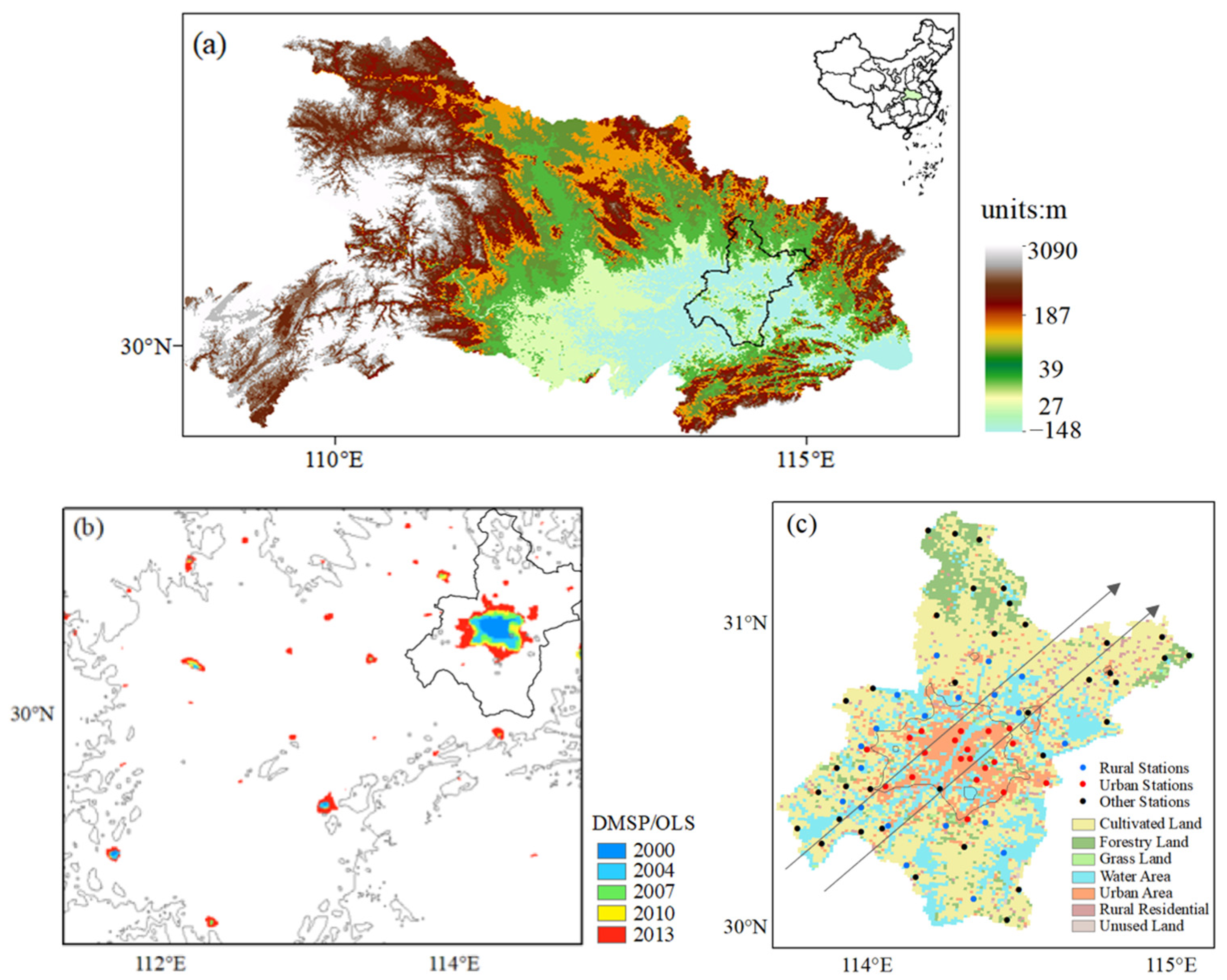
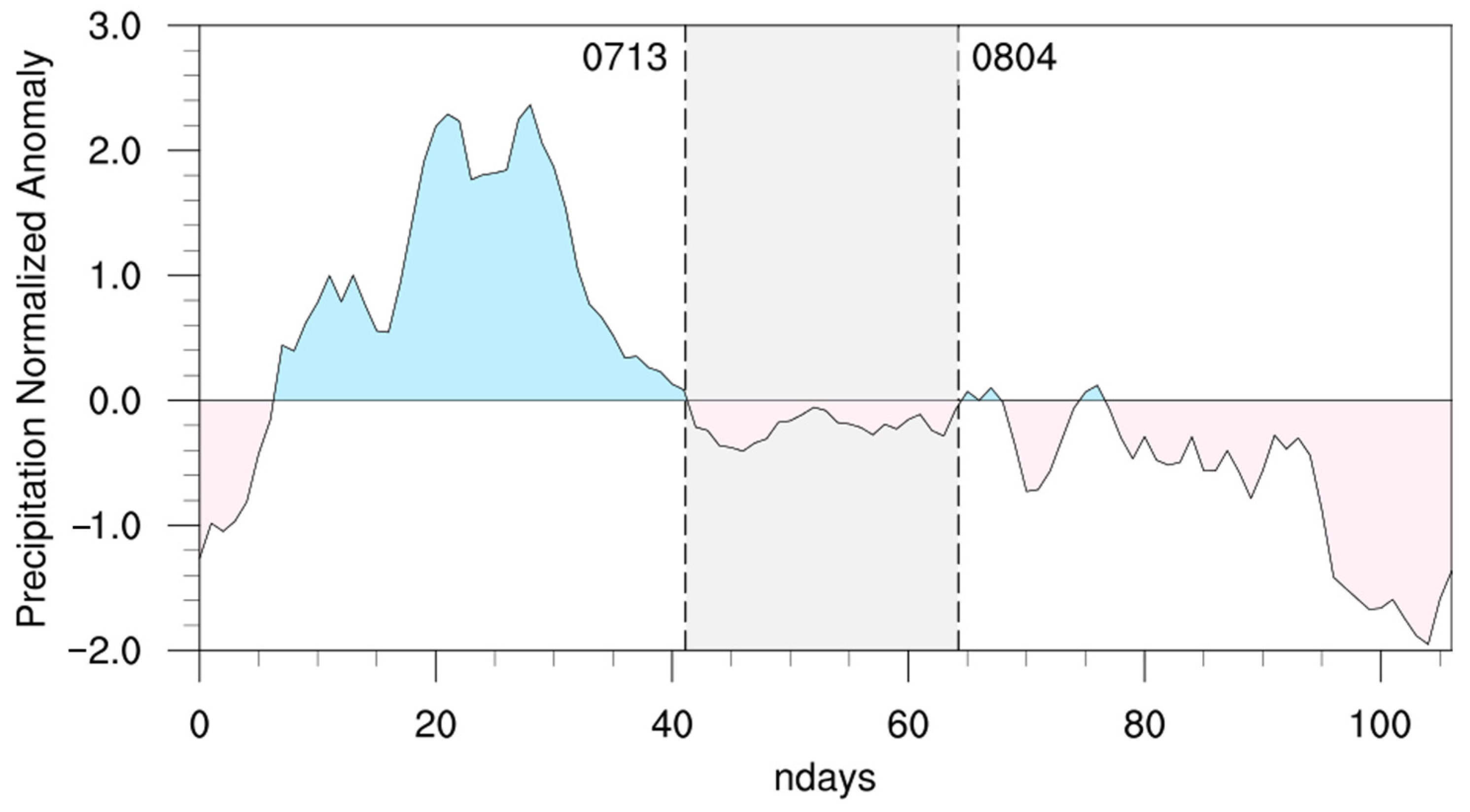

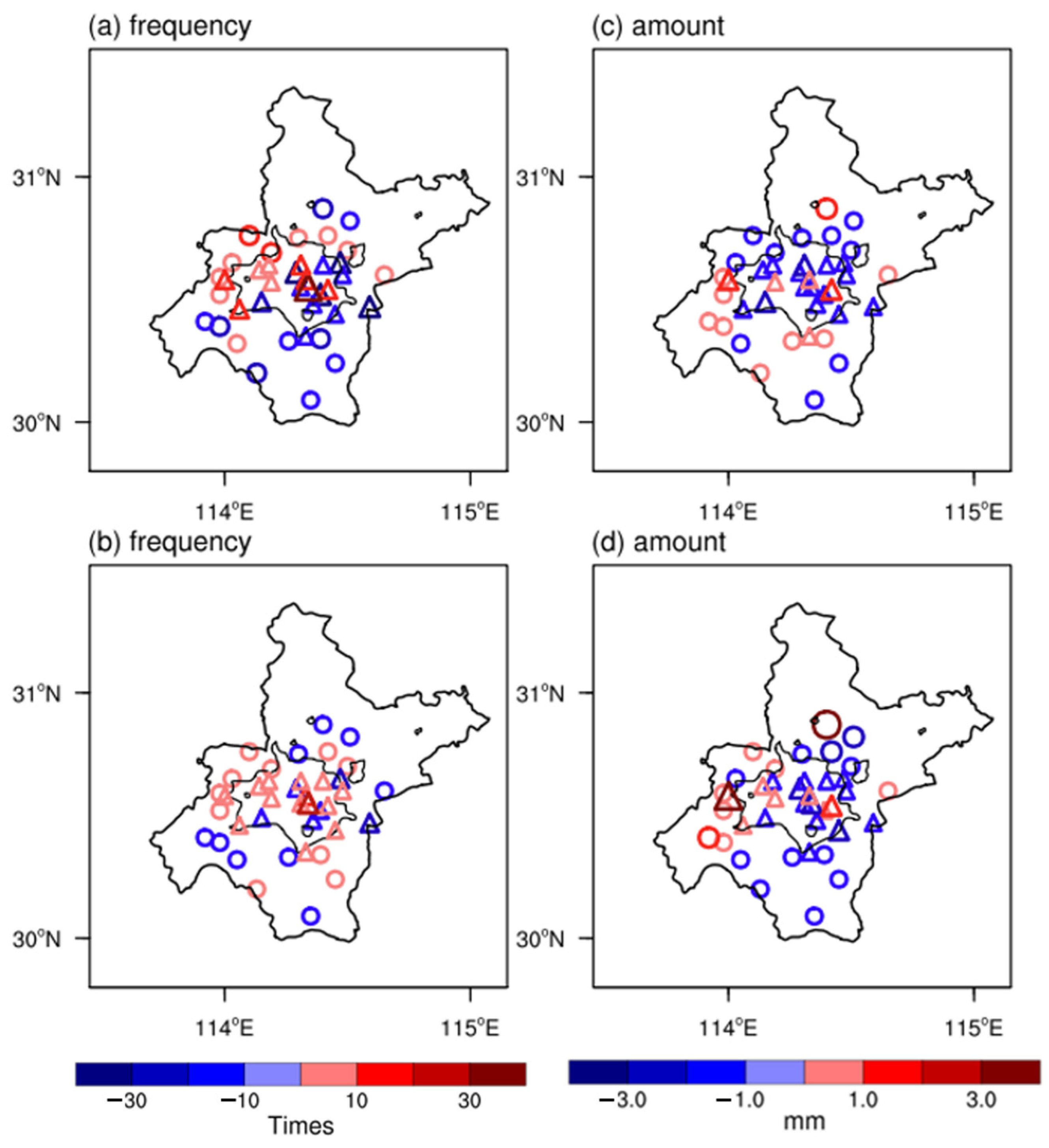
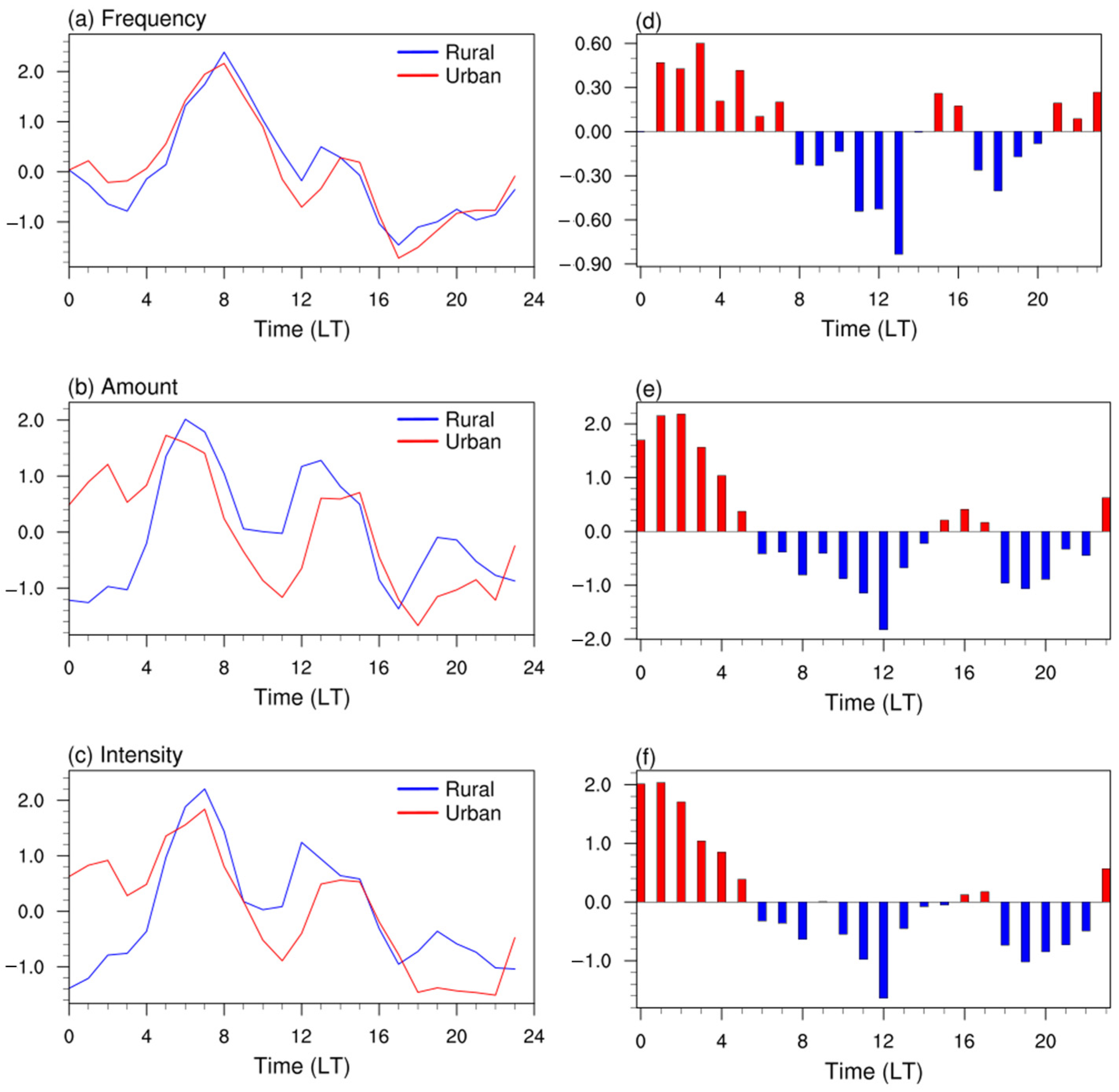
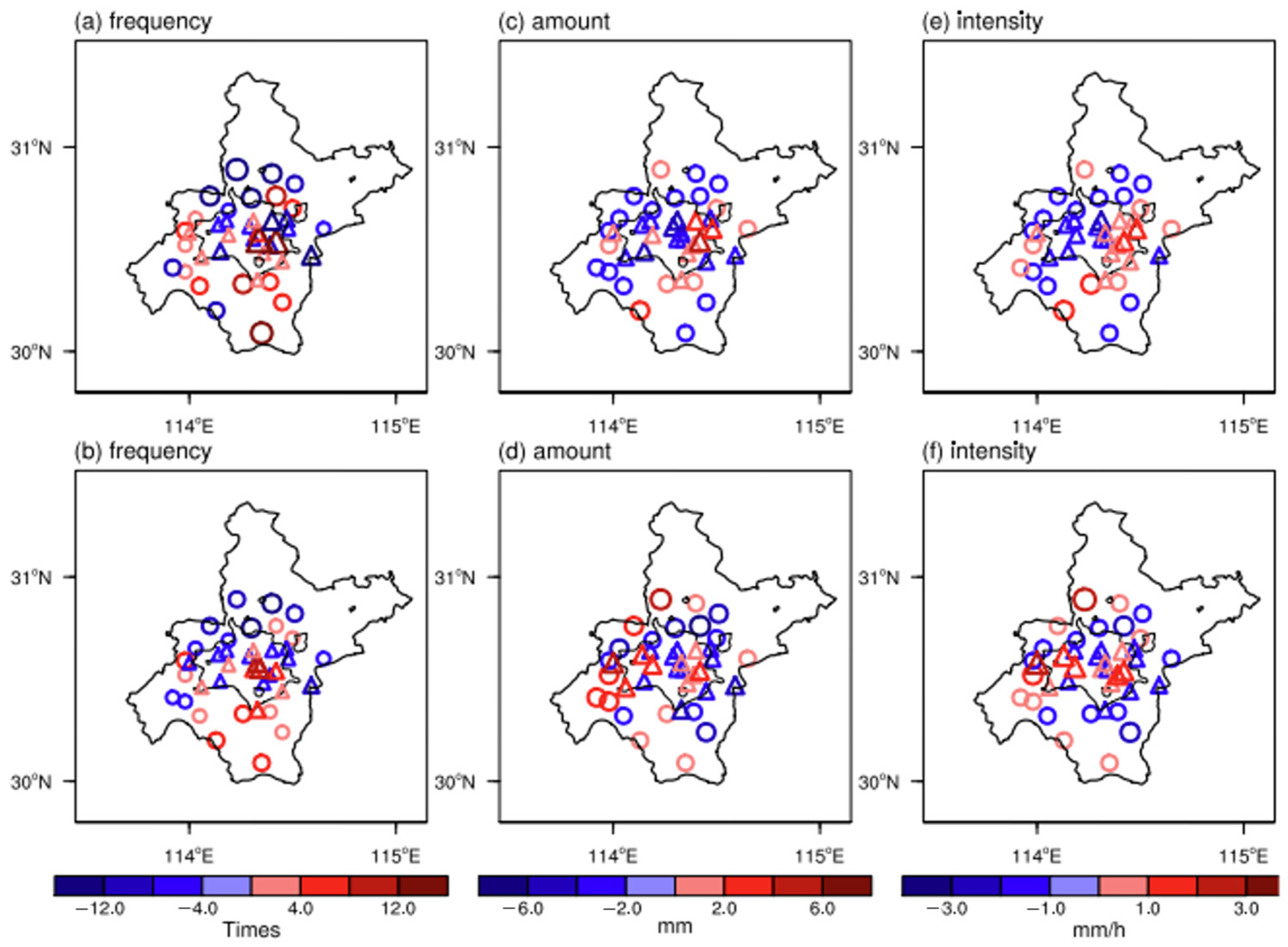

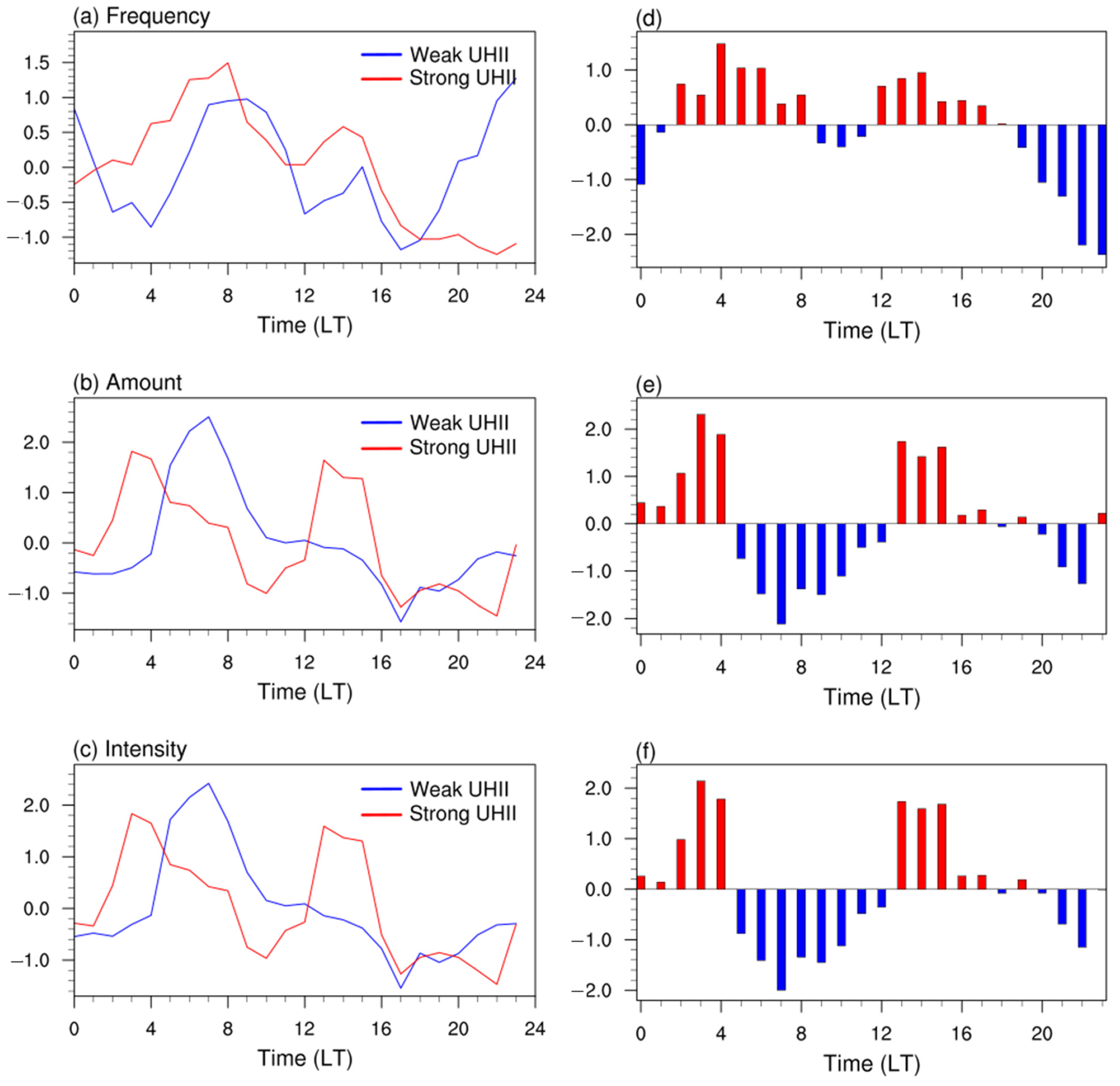
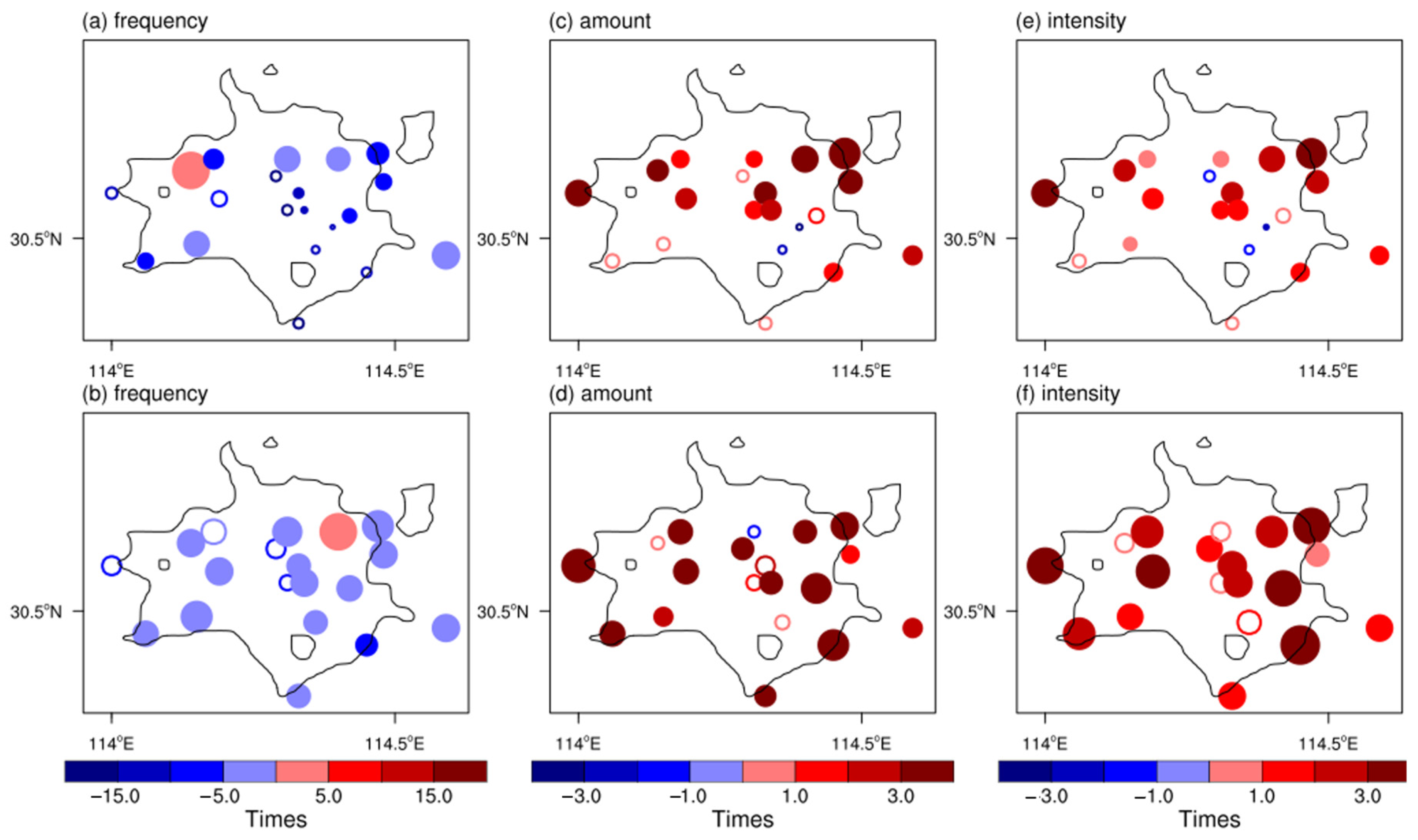

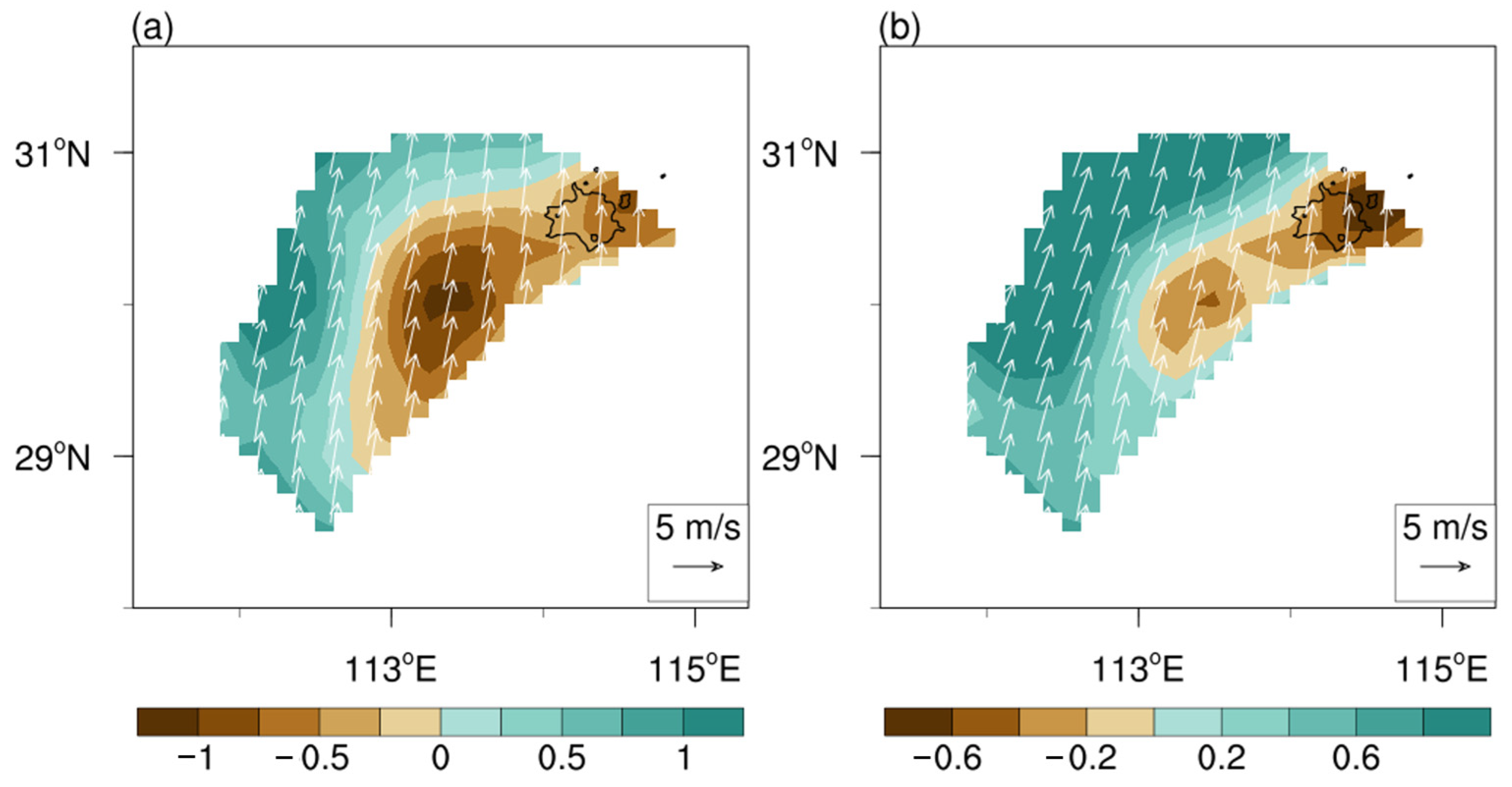
Disclaimer/Publisher’s Note: The statements, opinions and data contained in all publications are solely those of the individual author(s) and contributor(s) and not of MDPI and/or the editor(s). MDPI and/or the editor(s) disclaim responsibility for any injury to people or property resulting from any ideas, methods, instructions or products referred to in the content. |
© 2023 by the authors. Licensee MDPI, Basel, Switzerland. This article is an open access article distributed under the terms and conditions of the Creative Commons Attribution (CC BY) license (https://creativecommons.org/licenses/by/4.0/).
Share and Cite
Mao, Y.; Ren, G.; Tysa, S.K. Urbanization-Induced Diurnal Variation in Short-Duration Rainfall Events in Wuhan, China. Land 2023, 12, 1343. https://doi.org/10.3390/land12071343
Mao Y, Ren G, Tysa SK. Urbanization-Induced Diurnal Variation in Short-Duration Rainfall Events in Wuhan, China. Land. 2023; 12(7):1343. https://doi.org/10.3390/land12071343
Chicago/Turabian StyleMao, Yanlin, Guoyu Ren, and Suonam Kealdrup Tysa. 2023. "Urbanization-Induced Diurnal Variation in Short-Duration Rainfall Events in Wuhan, China" Land 12, no. 7: 1343. https://doi.org/10.3390/land12071343





